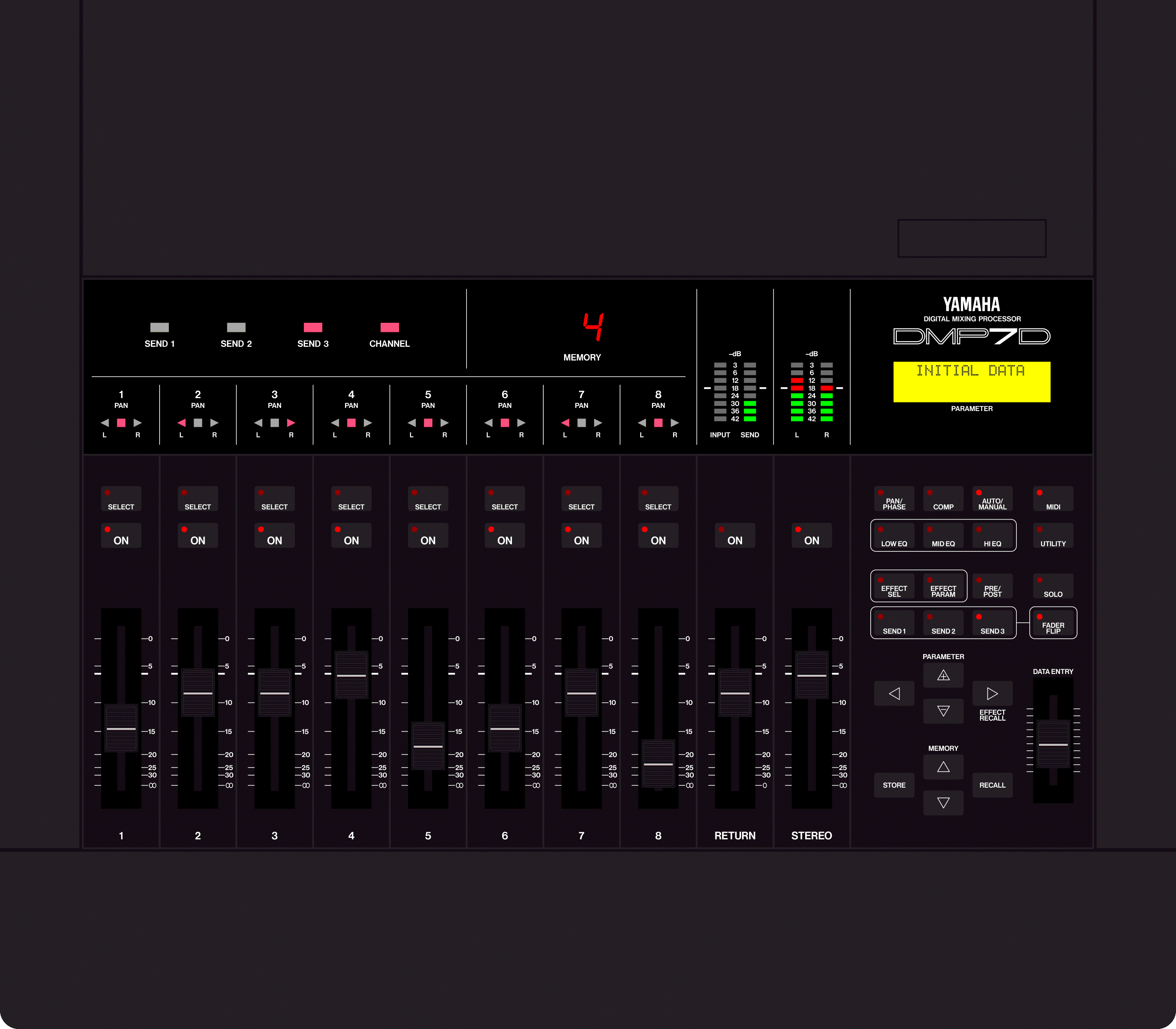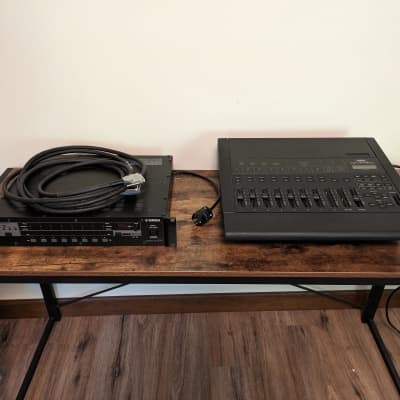1988 (Aug.)
Initially sold for ¥500,000
The DMP7D is a DMP7 with fully digital input and output connectors. It doesn't have internal ADCs or DACs so every conversion must happen outside of the unit.
The digital input connector can receive 8 channels of PCM audio, normally via one of the interface units Yamaha released alongside the DMP7D (IFU1, IFU2, IFU3 or IFU4) and supports the Yamaha format (AD808), the Sony PCM-3324 or PCM-1610/1630 formats, the Mitsubishi X-850 format or the Otari DTR-900 format. Additionally, digital audio from stereo CD players or DAT players can be received on channels 7 and 8.
The digital output connectors provide output signal in Sony format, either as RS-422 level via XLR-3-32 connectors or TTL level via BNC connectors. A stereo output signal is also provided for home-use DAT recorders or similar equipment.
If 8 inputs aren't enough, the DMP7D permits digital cascading of 2 more units (a 3m cascade cable was included in the box). Can optionally be controlled via an RTC1 remote.
Features
Compatibility with all digital formats
The DMP7D offers direct digital to virtually all types of professional digital recorders, processing units, and home-use DAT recorders. A range of interface units is available for broad input compatibility, while full output compatibility is provided directly via the DMP7D's output connectors.
A wide range of options
In addition to interface unites which allow connection to virtually all types of digital recorders, Yamaha offers A/D and D/A converter units for full analog-digital compatibility.
Selectable 44.1 kHz/48 kHz sampling frequencies
Switchable sampling frequencies provide compatibility with equipment that uses either frequency.
3 digital effects systems
The DMP7D provides 3 effect sends (loops) each of which contains a high-performance internal digital multi-effect processor. Effects Sends 1 and 2 each provide access to 17 different effects including reverb, gate reverb, delay, echo, flange, phasing, tremolo and symphonic.. Individual parameters controlling each effect may also be programmed. Effect Send 3 can feed either a 5-effect internal system or external signal processing devices via effect send and return patch points on the rear panel.
Reliable multi-function motorized faders
The channel, master, effect return and data entry faders are all motorized and digitally controlled. Like all other DMP7D parameters, fader settings can be memorized and recalled as needed. The faders physically move to the programmed positions, allowing visual confirmation of the mix.
Versatile digital EQ
Each DMP7D channel offers a versatile 3-band digital parametric equalizer. Each band permits frequency control, 15 dB of boost or cut, and bandwidth (Q) adjustment over a broad 0.1 – 0.5 range. The high and low bands also offer peaking and shelving response selection.
Internal stereo compressor
A separate digital stereo compressor system is internally provided for the stereo buss. Stereo compression of the master stereo signal is a must for many applications. With the DMP7D this capability is built-in.
Memory
The DMP7D features 30 internal memory locations which can store all console parameters. You can program and store 30 completely different processing configurations or "scenes", and recall them instantly whenever necessary. A cartridge slot is provided for an external Yamaha RAM4 memory cartridge which can store 67 additional configurations.
MIDI control capability
Stored configurations can be selected simply by sending the appropriate MIDI program change number to the DMP7. It can even be connected directly to a MIDI sequence recorder for real-time storage and playback of mixing and processing operations. For complicated operations involving simultaneous fades, EQ changes, etc., each operation can be individually overdubbed on the sequence recorder. Then you simply play back the sequence as you would with any other MIDI compatible musical instrument, and the entire mixing/signal processing process is recreated in fine detail.
- SOLO mode for individual channel monitoring.
- Programmable stereo panning control
- Effect, channel and stereo master peak meters.
- 16 character x 2 line LCD display.
- 2-digit 7-segment LED memory number display.
- Memory protection.
- Foot-pedal output level control. (by optional FC7)
- MIDI bulk dump capability.

